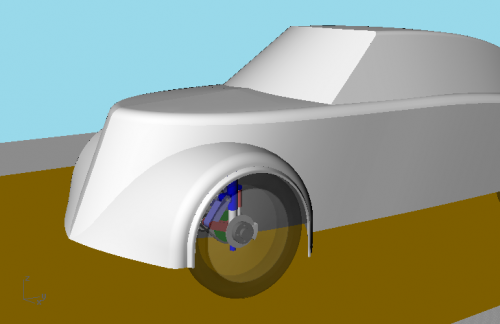Hi all,
I and a team of students are developing the "Payton Drive" modules I posted information about late last year. Here's a link to the team page: https://sites.google.com/a/uw.edu/e-dubs/home
Here's the original link I posted. Click Here.


Hi all,
I and a team of students are developing the "Payton Drive" modules I posted information about late last year. Here's a link to the team page: https://sites.google.com/a/uw.edu/e-dubs/home
Here's the original link I posted. Click Here.


There are currently 0 users online.
The idea of mounting the motor separately, to reduce "unsprung weight" is good, but I can foresee problems in the "Real World" relative to maintaining reliability after/during trips through salty water, ice/snow/sand, and gravel or other road debris. Exposed belts, chains, and or bearings would be subject to damage or shortened service life, or in some cases, immediate failure! Belts/chains do NOT like ingesting paper, leaves, grease, oil, plastic bags or other road debris such as sand and/or gravel between themselves and their pulleys, nor do they fare well for long if ingesting salty water, such as we have when roads are salted for wintertime driving. Cost to maintain and/or repair the system is important, as nobody will want a car that is "totaled" due to what would otherwise be a minor mishap!--Reliability when driven by idiots is important, as most motorists seem to have few mechanical or technical skills, and they also do not like vehicles that require frequent inspections and/or maintenance. Make it so that it survives and WORKS in spite of all this, but can also be economically rebuilt or repaired, and you may have a winner!--Bob Curry
Robert M. Curry
These are all valid concerns. As far as strength and durability, nothing here is new and the mechanisms employed are commonly employed on aircraft and cars. Furthermore, the durability depends on how the system is implemented which applies to every invention ever conceived. Someone's even pointed me recently to the Bond 3 wheel mini-car which used a single cylinder engine on a (rougly) similar drive module (the engine turns with the wheel and is attached to the suspended side of the module) and there were no problems there either.
Secondly, there are chains and belts exposed on all sorts of vehicles from Harleys to Honda motorcycles to light EV's and they don't seem to display any significant wear issues, whether salt exposed or not. Hence, there hasn't exactly been a rush to switch to shaft drive in those applications. Beyond these facts there is the fact that the chain/belt can easily be enclosed and likely would be. The illustrations on our site and even our prototypes are/will be the raw initial iteration of the idea. Simple improvements like this are easily conceivable.
For anyone commenting, I realize that it's pretty easy and reflexive to hunt and peck for negative aspects of an idea. If you must, please at least think things over on your own and look at precedent before commenting negatively. Also, if you must comment negatively, refrain from doing so without accomanying that comment with one or more proposed solutions to your point. Most of what I've pointed out here is pretty obvious and doesn't take PHD in mechanical engineering. Better still, don't just assume things. Ask questions instead because a lot of assumptions are wrong and it wastes time and effort to address them.
Thanks.
As far as your response to my concern about the chain/belt drive, It seems apparent that you have not operated a chain driven vehicle for any great distance (Over 50,000 miles) in all-weather conditions! As a person that HAS operated both HARLEYS and HONDAS for over 50,000 miles, I can state that I do not know of any CHAIN DRIVE that will still be servicable after operation and exposure to the elements for 50,000 miles! Long before reaching that milage, I found that numerous adjustments and lubrications/cleanings were required, and by 25,000 miles or less, the sprockets and/or chains were noticably worn and out of specification. The only reason this seems acceptable to many motorcyclists is that most seldom ride in the rain, and VERY FEW ever attempt to ride in SNOW and ICE conditions, when the SALT and SAND is heavily used on the roads! Salty, sandy road grit can destroy a motorcycle chain and sprockets in only ONE season of attempted use! Belt drive, as used on some Harley Davidsons, fares better, but is damaged if operated where sand can repeatedly be introduced between the belt teeth and sprocket, and most such belts are adversely affected by oil, and other chemicals that splash op onto the drivetrain when operated in wet weather on heavily traveled roads, such as we have in Washington, D.C. and other major population centers. Again, most users of these vehicles do NOT operate them in such conditions, and tend to not operate them as many miles as a CAR driver would. I find it RARE to find a motorcyclist that rides an average of 10,000 miles per year or more for 5 years or more, but quite easy to find operators of CARS that equal or exceed 10,000 miles annually. For many motorcyclists, if maintanence were required at 3,000 miles, and replacement(of the chain/belt/sprockets) at 12,000 miles, they would be happy, as maintanence would be only once or twice a year, and replacements would be after 3 or 4 years! CAR drivers generally expect drivetrains to have a LONGER LIFE, with less servicing, and normally DO operate the vehicles in severe weather, for much greater annual distances! For these reasons, your comparison is NOT a good one! I drive cars, vans, and motorcycles here in the Washington D.C. suburbs, and have done so for over 40 years. I have over 100,000 miles on my present Motorcycle, a 1994 Honda Goldwing, with SHAFT drive, as I tired of the problems experienced with chains and belts! (belts were better than chains, but more trouble/expensive to replace)I have had plastic bags get caught in the drive chain-many people throw such trash out onto the roadway! Remember: Good weather vehicle, low annual milage average,=Motorcycle/scooter, and All-Weather vehicle, high annual milage, CAR. There are BIG differences in what customers and users will expect and tolerate!(CAR drivers expect the car to operate reliably at 10 below zero, in 6 inches of snow and/or ice slush, or a torrential summer downpour that sends motorcyclists scurrying for cover!)-Bob Curry
Robert M. Curry
O.K.
Do you mind telling me what part of all this stuff that enclosing the chains (AS MENTIONED ALREADY) wouldn't help?
Again, if you have to comment negatively, fire a neuron or two and consider a solution. Otherwise, the extra wind isn't helpful or necessary.
None of this was negative!
Designtech 3000, you seem to be getting you knickers into a twist over nothing!
If you post here, which is most welcome, then you need to be open to replies from people who do not spend 90% of their energy on making it sound nice and politically correct. Get over it.
I really like your idea of publishing designs so as to make it unlikely that it gets locked down by patents!
One way of locking it down would be to invent a "dirt and salt-solution proof housing for "Payton-Drive-like-drive systems"......and then take out a patent on it!
Now to firing a neuron: How about including a transmission (of any kind for patent prevention purposes), preferably a CVT with dirt proof housing?
That would allow many different types of electric (and other?) motors to provide the torque for the Payton drive! The very powerful but lightweight RC motors, together with Fechters throttle interface come to mind!
This information may be used entirely at your own risk.
There is always a way if there is no other way!
"If you post here, which is most welcome, then you need to be open to replies from people who do not spend 90% of their energy on making it sound nice and politically correct. Get over it."
I bet saying stuff like that makes you feel good but it's still meaningless and irrelevant. In fact, you're being "politically correct" in saying this because it's a popular, thing to say.
You seem to have your own "knickers in a twist" because I didn't spend 90% of my energy being "politically correct" in pointing out the flaws in his comments. You "Get over it."
As for patenting different add-ons there are millions upon millions of variations on this thing and they can't all possibly be covered. Beyond that, the intent is to give people the tools to make things themselves, that's why I'm open sourcing it. In the open source world you don't grand stand and criticize from the sideline. You pick things up, improve them, and say "Hey, I made it better by doing this!." In other words, pick it up and make it better or shut up and leave it alone.
No, you get over it first! I said it first, I said it first, it's just not fair...
ROTFLMAO
This information may be used entirely at your own risk.
There is always a way if there is no other way!
design tech, I think you should learn and respect the LAWS of physics ! try studying and understanding the effects of friction on moving parts. the reasons for bearings, grease and oil, and abrasive effects of grit on the materials you plan on using to build this machine! also
you asked us to tell you what we think , advice is what it is.. If you chose to ignore that advice than you increase your odds of failure and in this day and age, failure can be expensive !! Learn from those who come before you and listen you are the negative one! LaTeR
thank GOD I wake up above ground !!!!
Golden. Projecting oneself onto others.
Sounds all high and intellectual mentioning laws of physics and the like. That won't add any credibility to what you say.
The obvious solution of an enclosure has been mentioned several times but it seems eyes see while brains fail to process.
Talk about failure to "listen"?
OK-Back to real-world problems and practicality, an enclosure would definitely be required to protect the drivetrain, but it would need to be designed so as not to defeat the advantage of remotely mounting the motor. If the enclosure were too heavy, unsprung weight would increase significantly. The enclosure could also hinder inspection and servicing, making cost of ownership expensive. If ALL of the previous problems are solved, one MORE problem remains, and that involves vehicle SAFETY! If two or more such drive units were installed on the wheels of a vehicle, a means of preventing loss of directional control in event of failure of ONE of the two units must be included! It would be very likely that such a failure would otherwise cause the vehicle to strongly pull to one side, possibly into other vehicles or off the roadway into other objects. (Perhaps a system that can detect power delivery imbalances beyond a certain level, at which point BOTH units would shut down, or available torque would become greatly limited?)--Try driving a 4 wheeled vehicle, where driving power (or braking)is applied to only ONE wheel, to better understand the problem!-Bob
Robert M. Curry